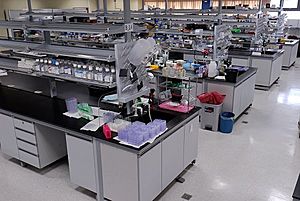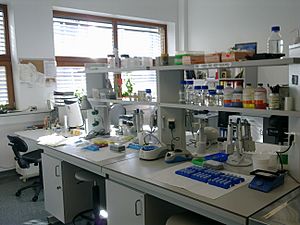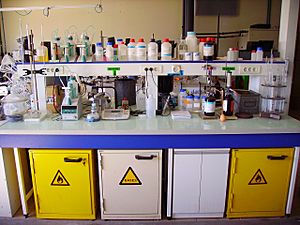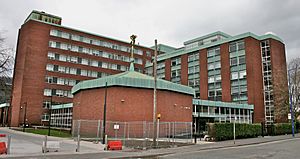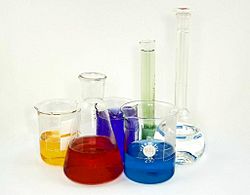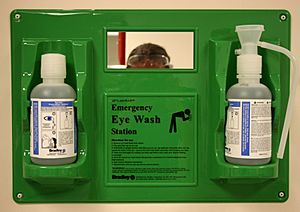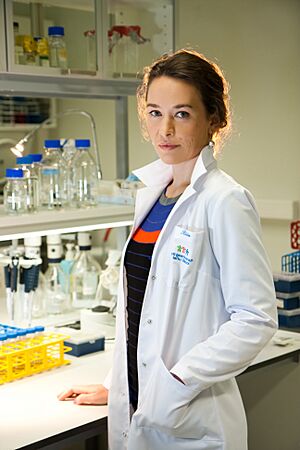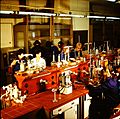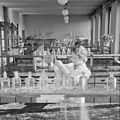Laboratory facts for kids
A laboratory or lab is a special place where scientists and engineers do important work. They use labs to do scientific research, conduct experiments, and make careful measurements. Labs are designed to provide the right conditions for these activities.
Contents
What is a Lab?
Labs come in many shapes and sizes because different types of scientists need different things. For example:
- A physics lab might have a huge particle accelerator to study tiny particles.
- A metallurgy lab works with metals, melting them or testing how strong they are.
- A chemist or biologist often uses a "wet lab" with lots of liquids and chemicals.
- A psychologist's lab might be a room with hidden cameras to watch how people behave.
- Computer scientists use powerful computers in their labs for simulations or to look at lots of data.
Engineers also use labs to design, build, and test new technology. You can find scientific labs in many places, like schools, universities, companies, government buildings, and even on ships or spacecraft.
Sometimes, the word "laboratory" is also used for workshops where people work together to solve problems or create new things. These are often called Living Labs or Fab Labs. People with different skills meet there to share ideas and resources.
History of Labs
The idea of a "laboratory" goes way back! Early labs were often used for alchemy (an old form of chemistry) or for making medicines.
Over time, labs grew bigger, especially after World War II. This was when "Big Science" started, leading to huge machines like particle accelerators.
Early Labs Through Time
One of the earliest known home labs belonged to Pythagoras, a famous Greek philosopher. He used his lab to study how sounds are made by vibrating strings.
In a famous painting from 1885, Louis Pasteur is shown working in his lab. He's comparing notes with a bottle, but he isn't wearing any special safety gear! Today, safety is much more important.
Working in teams became common in labs in the 19th century. Many new tools and machines for labs were invented in the 20th century.
An old underground alchemical lab from the 16th century was found by accident in 2002. People believe it belonged to Rudolf II, Holy Roman Emperor. This lab, called Speculum Alchemiae, is now a museum in Prague.
Lab Techniques
Laboratory techniques are the steps scientists follow to do an experiment in fields like chemistry, biology, and physics. All these techniques follow the scientific method. Some techniques use special lab tools, from simple laboratory glassware to complex electrical machines. Others need very specific or expensive supplies.
Lab Equipment and Supplies
Lab equipment includes all the different tools scientists use in a lab.
- Classic equipment includes things like Bunsen burners (for heating) and microscopes (for seeing tiny things).
- Specialized equipment can be more complex, like spectrophotometers (for measuring light) or calorimeters (for measuring heat).
Here are some examples of equipment found in different labs:
- Chemical labs often have
- laboratory glassware like beakers or reagent bottles.
- Analytical machines like HPLC or spectrophotometers.
- Molecular biology and life science labs often have
- autoclaves (for sterilizing tools).
- microscopes (for seeing cells).
- Centrifuges (for spinning liquids to separate things).
- Shakers and mixers (for mixing liquids).
- Pipettes (for moving small amounts of liquid).
- Thermal cyclers (for DNA work like PCR).
- Photometers (for measuring light).
- Refrigerators and Freezers (for keeping samples cold).
- ULT Freezers (for very cold storage).
- Incubators (for growing cells).
- bioreactors (for growing large amounts of cells).
- Biological safety cabinets (for working safely with germs).
- Sequencing instruments (for reading DNA).
- Fume hoods (for safely working with chemicals).
- weighing scales (for measuring weight).
- Reagents (chemicals used in experiments).
- Pipette tips and plastic containers (supplies for small amounts of liquids).
Lab equipment is used to do experiments, take measurements, and collect data. Bigger or more complex equipment is often called a scientific instrument.
Different Kinds of Labs
The word laboratory is also used for other places that have similar processes or equipment to scientific labs. These include:
- Film laboratory or Darkroom (for developing photos).
- Computer lab (for working with computers).
- Crime lab (for examining evidence from crime scenes).
- Language laboratory (for learning languages).
- Medical laboratory (for testing blood or other samples).
- Public health laboratory (for studying diseases in communities).
- Industrial laboratory (for testing products in factories).
Safety in Labs
Labs can have dangers, so safety is super important! Some dangers might be:
- poisons
- germs that can make you sick
- Things that can easily catch fire (like flammable liquids)
- Things that can explode (like explosive materials)
- Radioactive materials
- Moving machines
- Very hot or very cold temperatures
- lasers
- Strong magnetic fields
- high voltage electricity
Because of these dangers, safety rules are very important. Labs use safety equipment to protect people from getting hurt or to help in an emergency. This equipment can include lab coats, safety glasses, gloves, and eyewash stations.
In the United States, there's a special rule called the "Laboratory Standard" to keep labs safe. Every lab needs a Chemical Hygiene Plan (CHP). This plan explains the specific dangers in that lab and how to handle them safely. The CHP needs to be checked every year. Many labs have a Chemical Hygiene Officer (CHO) who helps create and manage this plan.
Labs also have regular checks to make sure everything is safe. They look at how chemicals are stored, electrical equipment, biohazards (biological dangers), and how waste is handled. Training is a key part of lab safety. Everyone who works in a lab needs to be trained on how to stay safe. This helps prevent accidents and injuries.
Images for kids
-
Thomas Edison in his lab, 1901.
See also
 In Spanish: Laboratorio para niños
In Spanish: Laboratorio para niños


